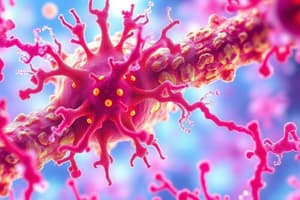Podcast
Questions and Answers
What type of test is used to determine if pathogenic organisms are present in a sample?
What type of test is used to determine if pathogenic organisms are present in a sample?
- Pregnancy test
- Urinalysis
- Blood glucose test
- Blood culture (correct)
Which area of clinical analysis focuses on the study of antigens and antibodies to determine immunity or disease presence?
Which area of clinical analysis focuses on the study of antigens and antibodies to determine immunity or disease presence?
- Radiology
- Immunology & Serology (correct)
- Endocrinology
- Histopathology
What is the purpose of Immunohematology (Blood Bank) in a clinical setting?
What is the purpose of Immunohematology (Blood Bank) in a clinical setting?
- Determine patient's heart rate
- Monitor lung function
- Perform brain scans
- Compatibility testing before blood transfusion (correct)
Which technology is commonly used in Molecular Diagnostics to study the presence of diseases or infections?
Which technology is commonly used in Molecular Diagnostics to study the presence of diseases or infections?
What is the primary focus of histopathology?
What is the primary focus of histopathology?
Which of the following is a routine test performed in urinalysis?
Which of the following is a routine test performed in urinalysis?
What does the chemistry department primarily perform?
What does the chemistry department primarily perform?
Which phase of sample testing involves studying urine pH, glucose, and protein levels?
Which phase of sample testing involves studying urine pH, glucose, and protein levels?
What is the historical purpose of phlebotomy as mentioned in the text?
What is the historical purpose of phlebotomy as mentioned in the text?
Which physician is considered the Father of Medicine and contributed to early medical theory related to phlebotomy?
Which physician is considered the Father of Medicine and contributed to early medical theory related to phlebotomy?
What was the purpose of venesection, a phlebotomy procedure done in the 17th- early 18th Century?
What was the purpose of venesection, a phlebotomy procedure done in the 17th- early 18th Century?
How did leeches become a modern method of bleeding in the 19th century?
How did leeches become a modern method of bleeding in the 19th century?
Study Notes
Microbiology and Immunology
- Pathogenic organisms are detected using microbiology tests.
- Clinical analysis focusing on antigens and antibodies is called Immunology.
- Immunohematology (Blood Bank) in a clinical setting determines compatibility for transfusions and detects antibodies against red blood cells.
Molecular Diagnostics
- Molecular technology, such as PCR (Polymerase Chain Reaction), is used to study diseases or infections at the molecular level.
Histopathology
- Histopathology focuses on the examination of tissue samples to diagnose diseases.
Urinalysis
- Routine tests in urinalysis include specific gravity, pH, protein, glucose, ketones, bilirubin, urobilinogen, and blood.
Clinical Chemistry
- The chemistry department primarily performs tests to measure the levels of various substances in bodily fluids.
Urine Analysis
- The prescriptive phase of sample testing involves studying urine pH, glucose, and protein levels.
Phlebotomy History
- Historically, phlebotomy involved the removal of blood to balance "humors" in the body.
- The Father of Medicine, Hippocrates, contributed to early medical theory related to phlebotomy.
- Phlebotomy was used to treat ailments by balancing "bad blood" through venesection, a phlebotomy procedure popular in the 17th-early 18th Century.
- Leeches became a modern method of bleeding in the 19th century.
Studying That Suits You
Use AI to generate personalized quizzes and flashcards to suit your learning preferences.
Description
Test your knowledge on cultures samples to determine pathogenic organisms, sensitivity to antibiotics, antigens, antibodies, and immunity. Learn about different tests like blood cultures, stool and urine cultures, and Mycobacterial culture.




